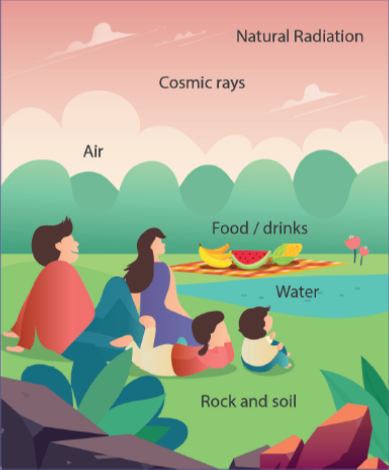What is Radiation?
What is Radiation?
|
|
|
Types of Radiation
Radiation can be classified as non-ionising and ionising:
- non-ionising radiation – e.g. visible light, signals from mobile phones, and radio waves;


- ionising radiation – e.g. radiation emissions from uranium ore, and high frequency waves in the electromagnetic spectrum such as x-rays.
.png)

Types of Ionising Radiation
In general, the most common types of ionising radiation are:
- Alpha particles have little power of penetration and can be easily stopped by a sheet of paper or the outer layer of the skin. However, alpha emitting materials are harmful to health if they enter the body by inhalation or along with food or drinks.
- Beta particles are generally high speed electrons and are more penetrating than alpha particles. A sheet of aluminium of a few mm thick can stop beta particles.
- X-rays and gamma rays are both very penetrating and can pass right through human body. Dense materials such as lead or concrete are more effective in absorbing these rays.
- Neutrons do not carry any electric charge and are constituents of atomic nuclei. Hydrogen-rich materials, such as water or paraffin can help shield against these highly penetrating particles.
.png)
Sources of Radiation
There are two sources of radiation: natural and artificial (man-made).
Natural Radiation
Natural radiation includes radioactivity in the rocks and soil of the Earth’s crust; radon, a radioactive gas given out by many volcanic rocks and uranium ore; cosmic radiation; and radioactivity in food and drinks. Natural radiation accounts for about 80% of the radiation doses to which we are subjected. It may vary from place to place.
Artificial (man-made) Radiation
Medical use of radiation is the most significant source of man-made radiation. This includes diagnostic radiology, nuclear medicine imaging and radiation therapy. Radiation arising from human activities typically accounts for about 20% of public exposure. Exposures due to fallout and nuclear discharges constitute very little.
|
|
|
Radiation in Daily Life
This diagram illustrates the examples of radiation in daily life, including natural background radiation as well as artificial exposures of medical radiation like X-ray and CT scan. The annual natural background radiation, from cosmic rays and radon gas from ground, etc., has a dose of about 2.4 millisievert (mSv). As for man-made radiation, the general dose level from single abdominal x-ray and CT scan are 0.6 and 6.6 mSv respectively, while the annual dose limit for radiation workers is 20 mSv. .png)
How does Radiation Affect People?
When a human body receives a high radiation dose of more than 1 Sievert (Sv) (1,000 mSv) in a short time, acute radiation effects, such as nausea, vomiting, fatigue and loss of hair may occur. Whole body radiation dose of above 10,000 mSv is life threatening even with medical treatment.
There will be no immediate health effects if the dose level is below a few hundred mSv. In the long-term, radiation can increase the risk of cancer. For every additional mSv of radiation exposure, the risk may increase by about 1 in 20,000.
According to international standards, the generic criteria of projected effective dose for evacuation or sheltering during a nuclear accident is 100 mSv in the first 7 days and that for thyroid blocking is 50 mSv to the thyroid in the first 7 days.



 radiation 1.png)
 radiation 2.png)